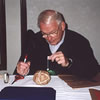
Make a Classroom Map
| Summary: |
Students map the desks in their classroom to understand the importance of coordinate systems and how to see their environment from a difference perspective. | Materials:
|
| Source: |
Windows to the Universe modified this activity from one by Scholastic Cooperative Learning. | |
| Grade level: |
6-10 | |
| Time: |
10 minutes prep time and 50 minutes class time | |
|
Student Learning Outcomes:
|
|
|
| Lesson format: |
Hands on activity that requires teamwork! | |
| Standards Addressed: |
DIRECTIONS:
- Mark each wall of the classroom with the cardinal directions (North, South, East and West). Make sure desks are oriented with their edges facing each cardinal direction.
- Have students orient their worksheets so that the north arrow faces the north end of the classroom.
- How big is the classroom? Have student groups use a tape measure to find the dimensions of the room in feet. If every mark on the worksheet is a foot, how would you draw the classroom perimeter onto your worksheet. (Remind students to pay attention to the orientation of their map as well as the length of the walls.)
- Mark a scale on the map. A scale is the ratio between the distance on the map and the distance in the real world.
- For each desk in the room, measure the distance of one corner from the north or south wall and the east or west wall. Mark the distances on a data table and the point on your map.
- Then measure the same distances for the opposite corner (i.e., if you did the northwest corner of the desk, you will also need measurements for the south east corner to know the total size... assuming the desks are roughly square or rectangular).
- Draw lines to connect the points into the shape of the desk.
- Fill in desks with one color and the rest of the room with another color.
- Make a key to the colors on your worksheet.
- Title the map to describe its location (i.e., Mrs. Potter's classroom) and the features it shows (i.e., location of desks).
ASSESSMENT:
Ask the class to arrange the desks according to another map that you have made. For instance, all desks turned 90 degrees or located at the back of the room. (Students will need to use elements that were important when they made their own maps such as cardinal directions and the "latitude/longitude" measured from the walls.
Have student groups look at world maps. Call out latitude and longitude values and have groups identify what country/ocean is at that location.
BACKGROUND INFORMATION:
Understanding latitude and longitude is essential for understanding maps. Using longitude and latitude, a grid of imaginary lines created by geographers, it is possible to identify the location of any point on the Earth's surface. In this activity students discover why latitude and longitude are important!
Latitude lines are concentric circles oriented in an east-west direction around the globe. At the equator the latitude is zero, while at the North Pole it is 90 degrees North and at the South Pole it is 90 degrees South.
Longitude lines are oriented in a north south direction running from pole to pole. Longitude lines are numbered around the globe starting with 0 degrees at Greenwich, England. Travel east from Greenwich and you will get to increasingly higher numbers of east longitude. Travel west from Greenwich and you will get to increasingly higher numbers of west longitude. On the other side of the globe (in the Pacific Ocean), east and west longitudes meet at 180 degrees.
Also in this activity, students are exposed to the cardinal directions, scale, the importance of orienting a map and making a key. These aspects of map are essential for both the person making the map and the people using it!
OTHER RESOURCES:






